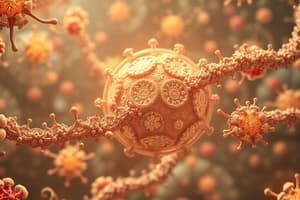Podcast
Questions and Answers
What is the primary goal of understanding the functions of medicines and drugs?
What is the primary goal of understanding the functions of medicines and drugs?
- To study their chemical structures without practical applications
- To understand the molecular dynamics of drug-receptor interactions
- To develop new drugs for recreational purposes
- To classify them and determine their applications (correct)
Which of the following is NOT a class of drug targets mentioned in the text?
Which of the following is NOT a class of drug targets mentioned in the text?
- Enzymes
- Transporters
- Nuclear hormone receptors
- Antibodies (correct)
What is the primary function of ion channels as drug targets?
What is the primary function of ion channels as drug targets?
- To regulate gene expression in the nucleus
- To transport molecules across cell membranes
- To regulate the flow of ions across cell membranes (correct)
- To catalyze chemical reactions in cells
Which of the following is an example of a therapeutic effect that could result from targeting enzymes with drugs?
Which of the following is an example of a therapeutic effect that could result from targeting enzymes with drugs?
What is the primary role of receptors in the context of drug interactions?
What is the primary role of receptors in the context of drug interactions?
What is the purpose of classifying drugs based on their functional interactions with biological organisms?
What is the purpose of classifying drugs based on their functional interactions with biological organisms?
What is the primary purpose of medicines and drugs?
What is the primary purpose of medicines and drugs?
Which type of drugs are used to provide relief from distressing symptoms associated with chronic or terminal illnesses?
Which type of drugs are used to provide relief from distressing symptoms associated with chronic or terminal illnesses?
Which of the following statements about the use of drugs for prevention is correct?
Which of the following statements about the use of drugs for prevention is correct?
What is one example of the experimental use of drugs?
What is one example of the experimental use of drugs?
Which of the following is an example of a drug target that can influence drug action and effects?
Which of the following is an example of a drug target that can influence drug action and effects?
What is the role of transporter proteins in drug action?
What is the role of transporter proteins in drug action?
Study Notes
Functions of Medicines and Drugs
Introduction
Medicines and drugs refer to chemicals that interact with biological organisms, primarily through receptors, to produce various effects. These substances can be classified into four types of targets: ion channels, enzymes, transporters, and nuclear hormone receptors, each with specific binding sites for drugs. The primary goal of understanding the functions of medicines and drugs is crucial for their classification and application, particularly in pharmacology.
Receptors as Drug Targets
Receptor theory plays a central role in defining drugs based on their functional interactions with biological organisms. Receptors are proteins within physiological systems that can either activate certain responses or block others through the same process of binding. These receptor proteins are classified into four distinct classes of drug targets, which have binding sites where drugs act:
-
Ion channels: These receptors regulate the flow of ions across cell membranes, controlling electrical signaling and cellular function. Some drugs target ion channels to produce effects such as muscle relaxation or heart rate changes.
-
Enzymes: Enzymes catalyze chemical reactions in cells, including those involved in metabolism, digestion, and signaling pathways. Drugs that inhibit enzymes can disrupt these processes, leading to therapeutic benefits or side effects. An example is acetylsalicylic acid, also known as aspirin, which blocks cyclooxygenase enzymes to reduce inflammation and pain.
-
Transporters: Transporter proteins facilitate the movement of molecules, such as neurotransmitters, across cell membranes, allowing for communication between cells. Drugs that interact with transporters can affect signal transmission, altering behavior, mood, or other physiological processes. Antidepressants, for instance, work by influencing the activity of neurotransmitter transporters like serotonin and dopamine.
-
Nuclear hormone receptors: These receptors control gene expression by binding to DNA, ultimately affecting cellular growth, development, differentiation, and reproduction. Steroid hormones and thyroid hormones act via nuclear hormone receptors, illustrating how drugs can influence genetic regulation for therapeutic purposes.
Functions of Medicines and Drugs
Medicines and drugs serve various functions depending on their intended use:
-
Therapeutic effects: Their primary purpose is to treat or prevent diseases, improve symptoms, and restore normal bodily functions. For example, antibiotics kill bacteria to combat infection, while insulin helps diabetics maintain blood sugar levels.
-
Palliative care: Medicines can provide relief from pain, nausea, anxiety, and other distressing symptoms associated with chronic conditions or terminal illnesses. Opioids are often used for pain management, while antiemetic medications help reduce feelings of nausea.
-
Prevention: Certain drugs are taken regularly to prevent disease progression or protect against specific risks. Vaccinations, for instance, trigger the immune system to create immunity against infectious agents, preventing future infections.
-
Experimental uses: Sometimes, drugs may undergo clinical trials to explore potential new treatments, investigational indications, or novel ways of addressing medical issues. One example is the exploration of cannabidiol (CBD) for its possible anti-inflammatory properties.
In summary, understanding the functions of medicines and drugs is essential for their correct use, classification, and development. By focusing on the interaction between drugs and their targets in the body—such as receptors, enzymes, transporters, and nuclear hormone receptors—we can better understand the mechanisms behind drug action and the beneficial or detrimental effects they can cause.
Studying That Suits You
Use AI to generate personalized quizzes and flashcards to suit your learning preferences.
Description
Explore the functions and targets of medicines and drugs in pharmacology. Learn about ion channels, enzymes, transporters, and nuclear hormone receptors as drug targets, and understand how medications are used for therapeutic, palliative, preventive, and experimental purposes.




